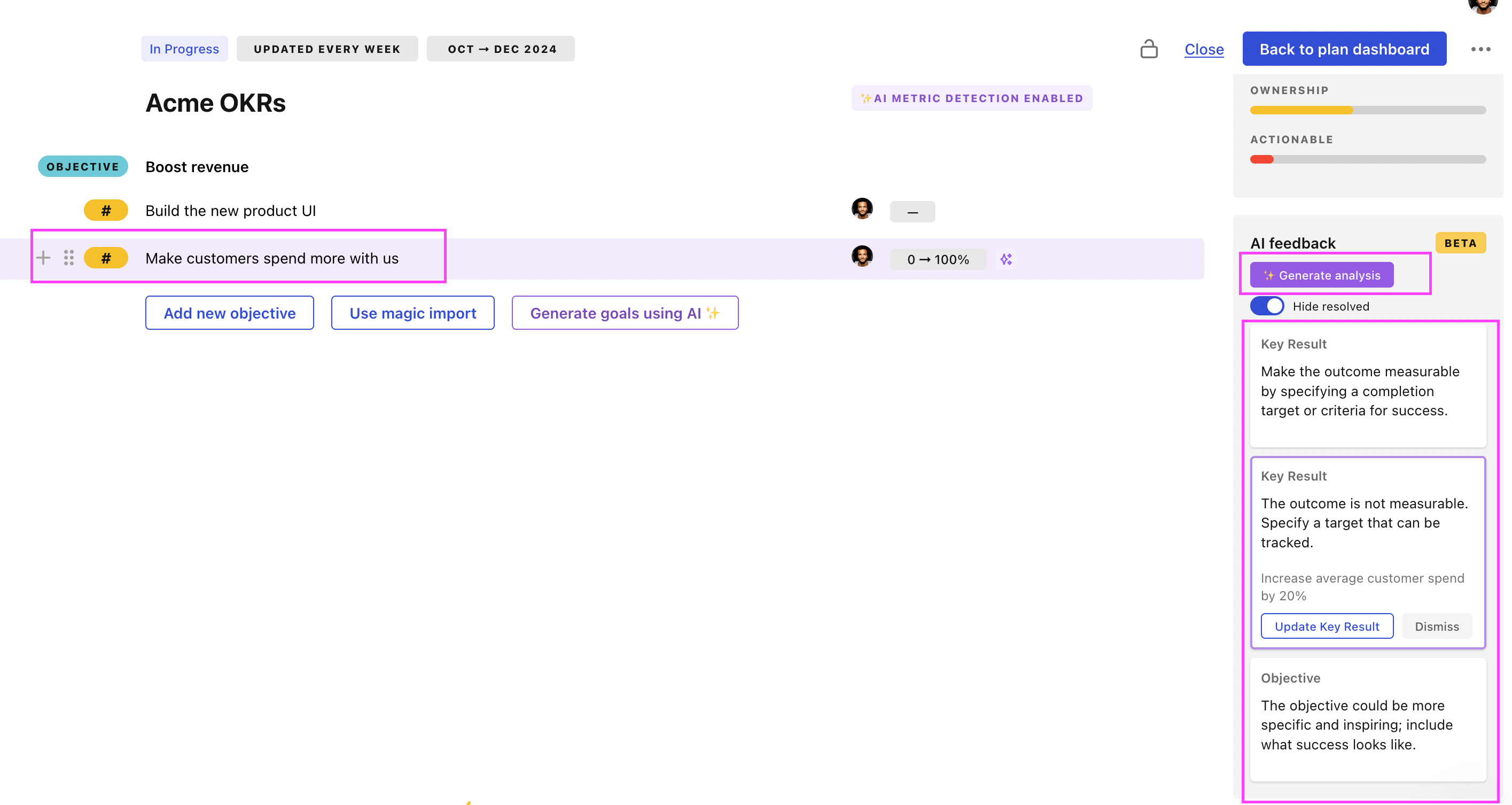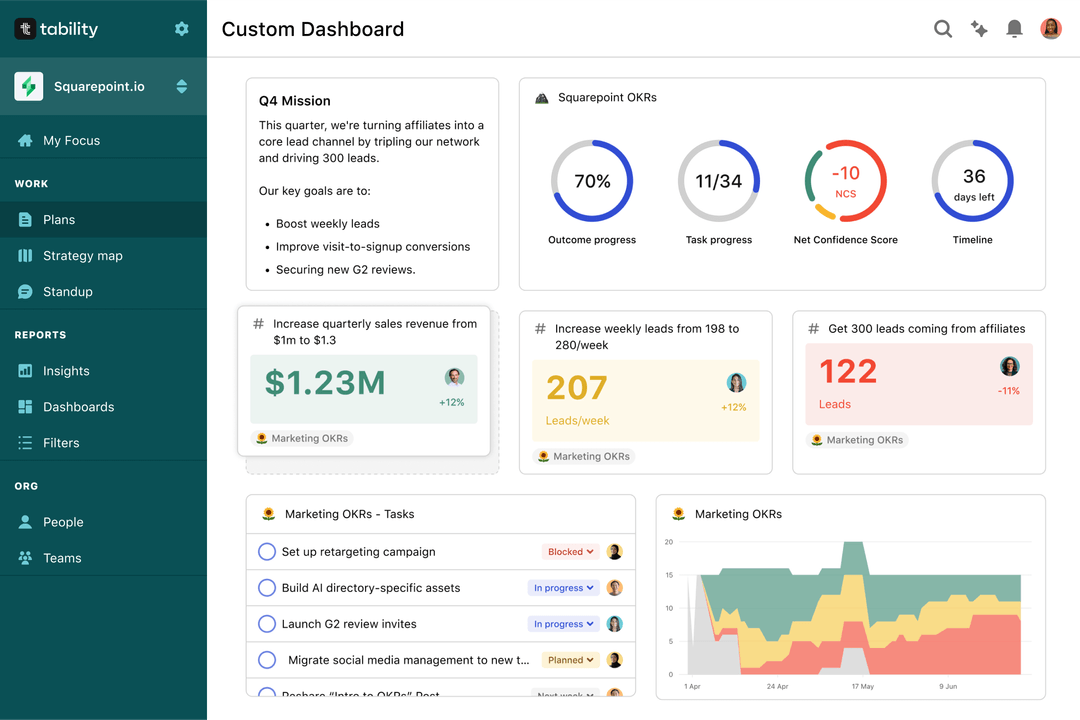Tability is a cheatcode for goal-driven teams. Set perfect OKRs with AI, stay focused on the work that matters.
What are Learning Strategies OKRs?
The OKR acronym stands for Objectives and Key Results. It's a goal-setting framework that was introduced at Intel by Andy Grove in the 70s, and it became popular after John Doerr introduced it to Google in the 90s. OKRs helps teams has a shared language to set ambitious goals and track progress towards them.
Formulating strong OKRs can be a complex endeavor, particularly for first-timers. Prioritizing outcomes over projects is crucial when developing your plans.
We've tailored a list of OKRs examples for Learning Strategies to help you. You can look at any of the templates below to get some inspiration for your own goals.
If you want to learn more about the framework, you can read our OKR guide online.
The best tools for writing perfect Learning Strategies OKRs
Here are 2 tools that can help you draft your OKRs in no time.
Tability AI: to generate OKRs based on a prompt
Tability AI allows you to describe your goals in a prompt, and generate a fully editable OKR template in seconds.
- 1. Create a Tability account
- 2. Click on the Generate goals using AI
- 3. Describe your goals in a prompt
- 4. Get your fully editable OKR template
- 5. Publish to start tracking progress and get automated OKR dashboards
Watch the video below to see it in action 👇
Tability Feedback: to improve existing OKRs
You can use Tability's AI feedback to improve your OKRs if you already have existing goals.
- 1. Create your Tability account
- 2. Add your existing OKRs (you can import them from a spreadsheet)
- 3. Click on Generate analysis
- 4. Review the suggestions and decide to accept or dismiss them
- 5. Publish to start tracking progress and get automated OKR dashboards

Tability will scan your OKRs and offer different suggestions to improve them. This can range from a small rewrite of a statement to make it clearer to a complete rewrite of the entire OKR.
Learning Strategies OKRs examples
You'll find below a list of Objectives and Key Results templates for Learning Strategies. We also included strategic projects for each template to make it easier to understand the difference between key results and projects.
Hope you'll find this helpful!
OKRs to promote mental agility and flexibility by embracing new learning strategies
ObjectivePromote mental agility and flexibility by embracing new learning strategies
KRImplement a study plan covering at least three distinct new subjects
Determine the three new subjects to study
Create a detailed syllabus for each subject
Allocate specific study time for each subject
KRMeasure improved comprehension on new topics, achieving 85% accuracy in assessments
Create targeted study plans to reach 85% accuracy
Analyze assessment results for improvement areas
Implement routine assessments on new topics
KRApply new learning strategies to solve complex problems in five separate scenarios
Implement strategies in each scenario
Research and select applicable learning methods
Identify five complex problems to tackle with new strategies
OKRs to improve academic performance through effective learning strategies
ObjectiveImprove academic performance through effective learning strategies
KRAttend 100% of revision classes and extra help sessions offered
Schedule all revision classes and extra help sessions in your calendar
Plan to minimize potential scheduling conflicts in advance
Regularly check updates for any session changes or additions
KRComplete and submit all assignments at least 48 hours before the deadline
List out all assignment deadlines
Start the work at least 72 hours before due date
Submit all assignments 48 hours early
KRAchieve an average of 90% or higher in weekly comprehension quizzes
Study notes and course material daily for better understanding
Practice with past quizzes to identify weak areas
Create a consistent study schedule to maintain focus
OKRs to develop and Enhance Learning Aptitude
ObjectiveDevelop and Enhance Learning Aptitude
KRAchieve 85% or higher on weekly learning aptitude assessments
Utilize practice tests to simulate actual assessments
Seek help for difficult topics from teachers or peers
Allocate daily study hours to grasp required learning material
KRImprove reading speed and comprehension by 30% through regular practice
Read daily for at least 30 minutes to increase speed and comprehension
Attend a speed reading seminar or course
Practice comprehension exercises from online resources
KRComplete 3 online courses on effective learning strategies
Consistently participate and complete coursework
Research and select three online courses on effective learning strategies
Register and pay for chosen online courses
OKRs to implement machine learning strategies to cut customer attrition
ObjectiveImplement machine learning strategies to cut customer attrition
KRDecrease monthly churn rate by 15% through the application of predictive insights
Prioritize customer retention strategies with predictive modeling
Enhance user engagement based on predictive insights
Implement predictive analytics for customer behavior patterns
KRImplement machine learning solutions in 85% of our customer-facing interactions
Develop and test relevant ML models for these interactions
Identify customer interactions where machine learning can be applied
Integrate ML models into the existing customer interface
KRIncrease accurate churn prediction rates by 25% with a refined machine learning model
Gather and analyze data for evaluating churn rates
Intensify machine learning training on accurate prediction
Implement and test refined machine learning model
Learning Strategies OKR best practices
Generally speaking, your objectives should be ambitious yet achievable, and your key results should be measurable and time-bound (using the SMART framework can be helpful). It is also recommended to list strategic initiatives under your key results, as it'll help you avoid the common mistake of listing projects in your KRs.
Here are a couple of best practices extracted from our OKR implementation guide 👇
Tip #1: Limit the number of key results
Focus can only be achieve by limiting the number of competing priorities. It is crucial that you take the time to identify where you need to move the needle, and avoid adding business-as-usual activities to your OKRs.
We recommend having 3-4 objectives, and 3-4 key results per objective. A platform like Tability can run audits on your data to help you identify the plans that have too many goals.
Tip #2: Commit to weekly OKR check-ins
Having good goals is only half the effort. You'll get significant more value from your OKRs if you commit to a weekly check-in process.
Being able to see trends for your key results will also keep yourself honest.
Tip #3: No more than 2 yellow statuses in a row
Yes, this is another tip for goal-tracking instead of goal-setting (but you'll get plenty of OKR examples above). But, once you have your goals defined, it will be your ability to keep the right sense of urgency that will make the difference.
As a rule of thumb, it's best to avoid having more than 2 yellow/at risk statuses in a row.
Make a call on the 3rd update. You should be either back on track, or off track. This sounds harsh but it's the best way to signal risks early enough to fix things.
Save hours with automated Learning Strategies OKR dashboards

OKRs without regular progress updates are just KPIs. You'll need to update progress on your OKRs every week to get the full benefits from the framework. Reviewing progress periodically has several advantages:
- It brings the goals back to the top of the mind
- It will highlight poorly set OKRs
- It will surface execution risks
- It improves transparency and accountability
Most teams should start with a spreadsheet if they're using OKRs for the first time. Then, you can move to Tability to save time with automated OKR dashboards, data connectors, and actionable insights.
How to get Tability dashboards:
- 1. Create a Tability account
- 2. Use the importers to add your OKRs (works with any spreadsheet or doc)
- 3. Publish your OKR plan
That's it! Tability will instantly get access to 10+ dashboards to monitor progress, visualise trends, and identify risks early.
More Learning Strategies OKR templates
We have more templates to help you draft your team goals and OKRs.
OKRs to enhance efficiency of core microservices like timeline and core list
OKRs to establish a strong personal brand for Carnevali's human management and project endeavors
OKRs to successfully transition core homepage components to new CMS
OKRs to improve and maintain stakeholder satisfaction
OKRs to enhance the operation and sustainability of the Asset Stores Metadata Repository
OKRs to implement versatile deployment strategies for K8's users